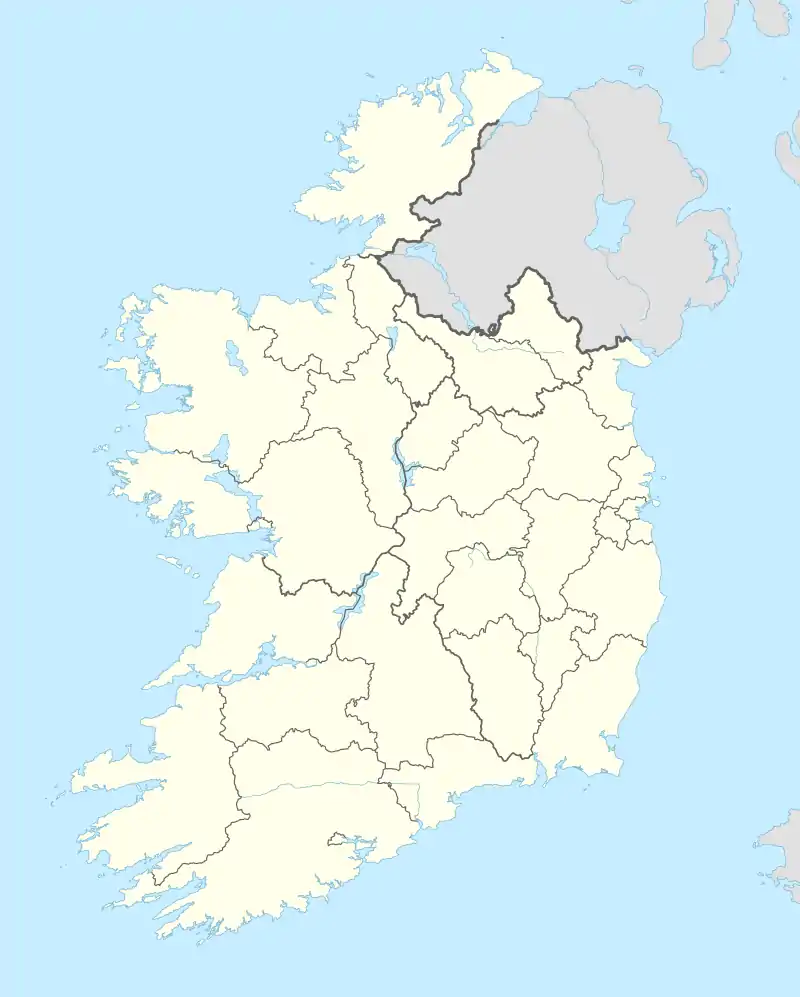Mainistir Eas Géitine | |
 | |
 Location within Ireland | |
| Monastery information | |
|---|---|
| Other names | Athskettin; Easa-geibhteine; Es-geibhteine; Inis-geibhthine; Easa-gebryny; Inisgebryny? |
| Order | Order of Friars Minor Conventual Order of Friars Minor |
| Established | 1389–1420 |
| Disestablished | 1714 |
| Diocese | Limerick |
| People | |
| Founder(s) | Gerald FitzGerald, 3rd Earl of Desmond |
| Architecture | |
| Status | Inactive |
| Site | |
| Location | Moig South, Askeaton, County Limerick |
| Coordinates | 52°36′14″N 8°58′31″W / 52.603813°N 8.975413°W |
| Public access | Yes |
| Official name | Askeaton Abbey |
| Reference no. | 185 |
Askeaton Abbey or Askeaton Friary is a ruined medievalFranciscan friary located north of Askeaton, County Limerick, Ireland, on the east bank of the River Deel.[1][2][3][4]
History

Askeaton Abbey was founded for the Order of Friars Minor Conventual by Gerald FitzGerald, 3rd Earl of Desmond between 1389 and 1400; or by James FitzGerald, 6th Earl of Desmond in 1420.[5]
The abbey was reformed under the Order of Friars Minor in 1490; it was reformed again in 1513 and a provincial chapter held there in 1564.[6]
Askeaton was plundered and later abandoned by Nicholas Malby's men in 1579 during the Second Desmond Rebellion, and some of the friars were killed.[7] It was revived in 1627 and abandoned in 1648 when Cromwell’s forces neared. It was reestablished in 1658 and continued to house friars until 1714.[8]
In 1914, four of the "ancient" bells of the monastery were found buried beneath the friary's "front door".[9]
Architecture
_(14764772525).jpg.webp)
The church and its north transept, sacristy, cloister arcade and domestic buildings survive. Notable features include the cloister with its carvings of Francis of Assisi with stigmata, a Mass dial, sedilia, several Fitzgerald dynasty tombs, and a carving of Christ as the Man of Sorrows.[5][10][11][12][13]
A sketch of the friary in the Pacata Hibernia, dated from some point prior to 1599, shows a large belfry associated with the structure, now entirely destroyed.[14]
The church is rendered in simple Gothic style and is lighted by a large window in the eastern wall. The gable and south wall are battlemented. A plain altar survives. Despite tradition attesting that the Stephenson family had removed the original altar to make a burial place beneath it, this is unlikely to be true.[15]
Gallery
References
Notes
- ↑ Westropp 1903, p. 240.
- ↑ Hourihane, Colum (18 November 2000). The Mason and His Mark: Masons' Marks in the Medieval Irish Archbishoprics of Cashel and Dublin. British Archaeological Reports Limited. ISBN 9781841711324 – via Google Books.
- ↑ Salter, Mike (18 November 2009). Abbeys and Friaries of Ireland. Folly Publications. ISBN 9781871731842 – via Google Books.
- ↑ Wordsworth, William (18 November 1969). "Letters of the Wordsworth Family from 1787-1855". Ardent Media – via Google Books.
- 1 2 "Askeaton Franciscan Friary". Monastic Ireland. Retrieved 25 December 2021.
- ↑ "A visit to Askeaton Friary". 30 April 2017.
- ↑ Berleth, Richard (25 June 2002). The Twilight Lords: Elizabeth I and the First Irish Holocaust. Roberts Rinehart. ISBN 9781461733478 – via Google Books.
- ↑ "Askeaton Franciscan Friary, Askeaton. County Limerick 1398".
- ↑ Westropp 1914, p. 166.
- ↑ Comerford, Patrick. "Strolling through the beautiful cloisters in Askeaton Friary".
- ↑ "Askeaton Friary, Co. Limerick".
- ↑ Leask, Harold Graham (18 November 1955). "Irish Churches and Monastic Buildings". Dundalgan Press – via Google Books.
- ↑ "Franciscan Monastery, Limerick". www.libraryireland.com.
- ↑ Westropp 1903, p. 241.
- ↑ Westropp 1903, p. 242.
Sources
- Westropp, Thomas J. (30 September 1903). "Notes on Askeaton, County Limerick. Part III. The "Abbey" (Continued)". The Journal of the Royal Society of Antiquaries of Ireland. 33 (3): 239–254 – via JSTOR.
- Westropp, T. J. (1914). "Bells of Askeaton Franciscan Friary, Co. Limerick". The Journal of the Royal Society of Antiquaries of Ireland. 4 (2): 166. ISSN 0035-9106.





